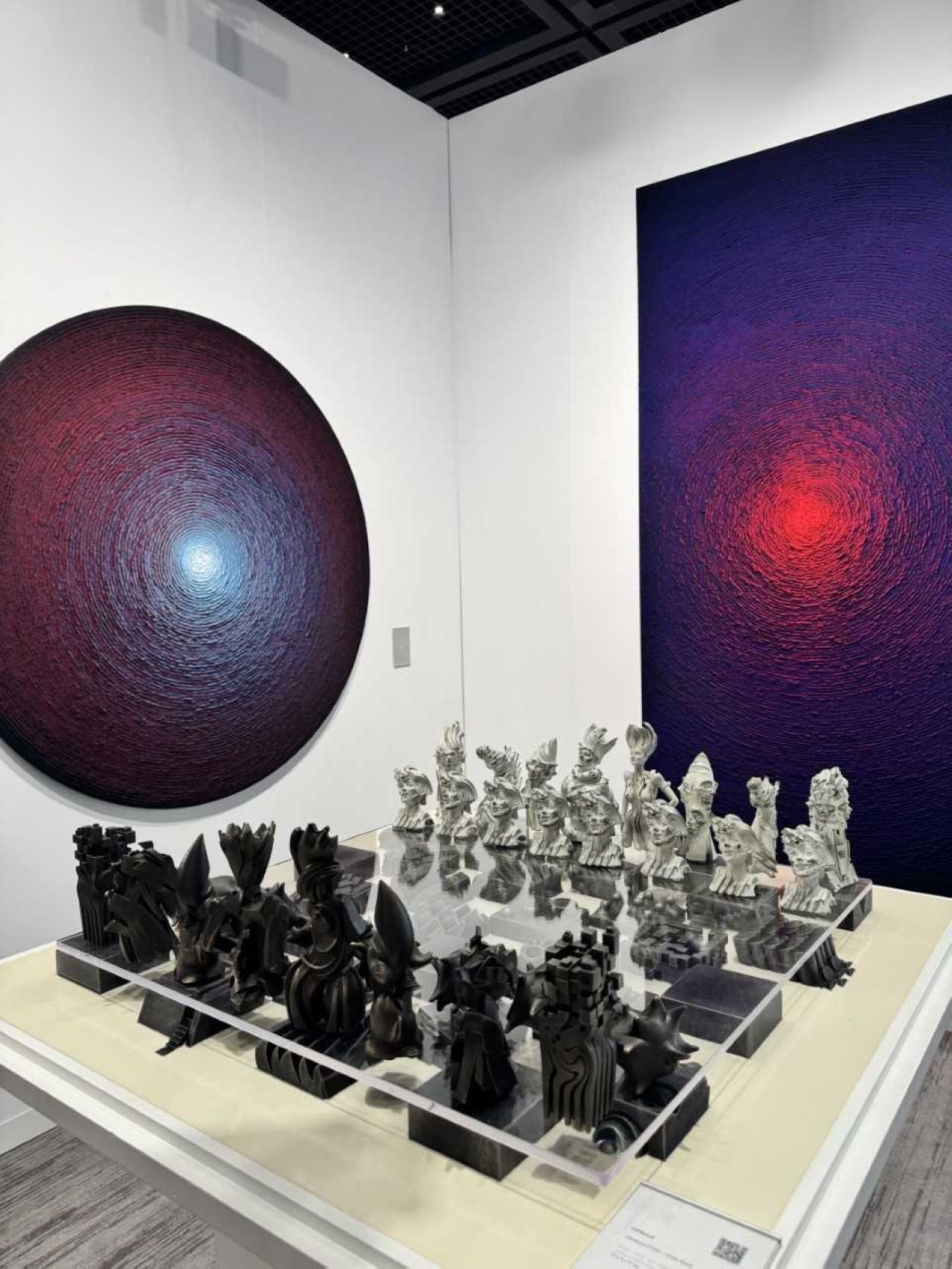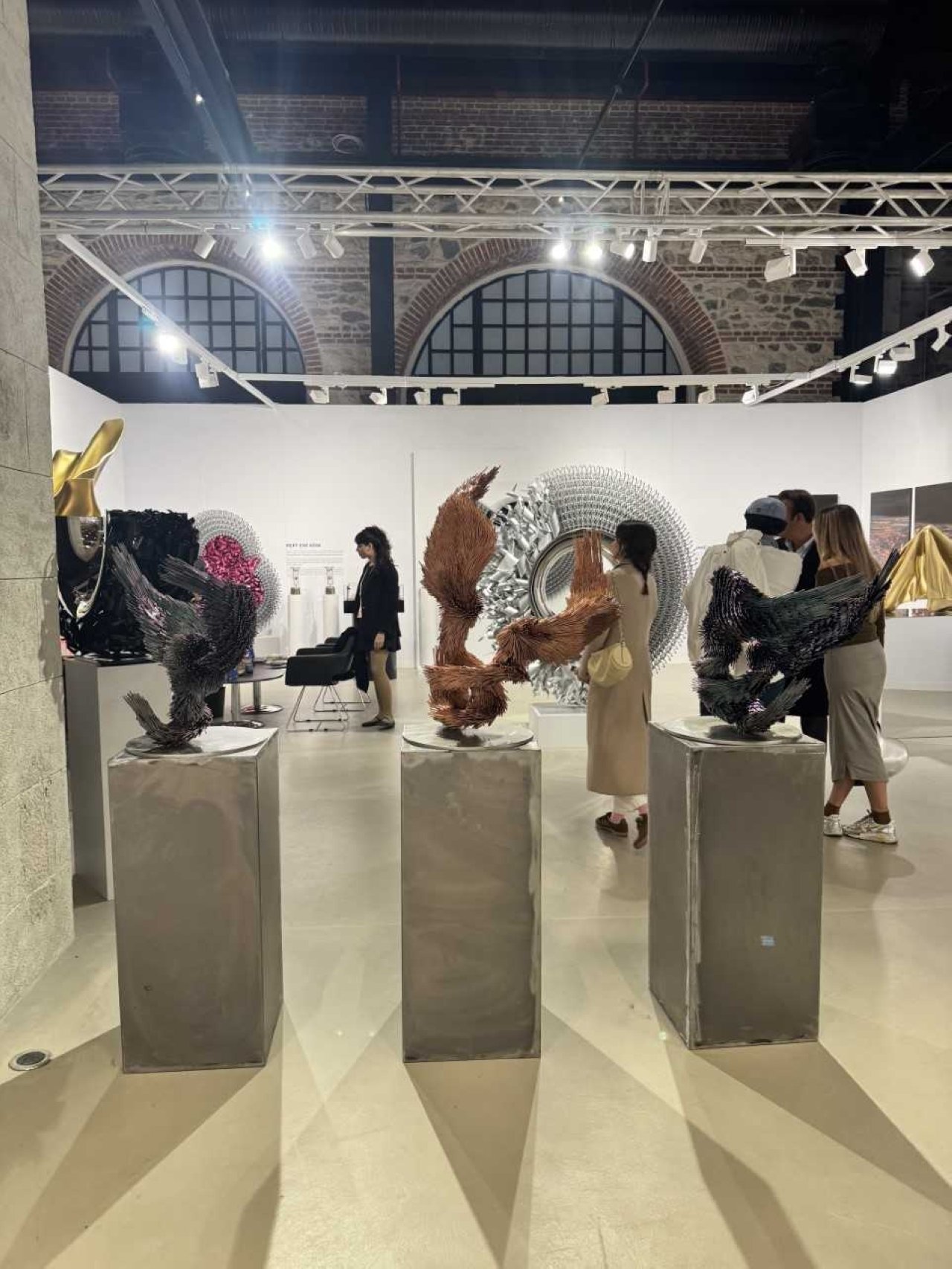© Turkuvaz Haberleşme ve Yayıncılık 2024
The 19th edition of Contemporary Istanbul, hosted in the historic Tersane Istanbul, showcased a compelling intersection of global and regional art. The fair featured 50 galleries from 14 countries and included over 800 works by more than 500 artists, underscoring Istanbul's growing prominence in the global art landscape.
This year, a strong emphasis was placed on Spanish and Latin American art through a "Guest Country" spotlight. The feature exhibition, "Born in the Seventies," presented 20 works from leading Spanish galleries, exploring the evolution of contemporary art in Spain and its global influences. This thematic curation enhanced the fair's international character, enriching Istanbul’s role as a hub for cross-cultural artistic dialogue.
A standout attraction this year was the "Yard" outdoor sculpture exhibition, curated by Marc-Olivier Wahler, with installations set against the scenic backdrop of the Golden Horn. These open-air pieces, alongside discussions on digital art in CIF Dialogues, reflect Contemporary Istanbul’s commitment to integrating emerging forms, such as AI, into the art environment.
The concept of "soft power," coined by political scientist Joseph Nye, refers to a country's ability to influence others through attraction rather than coercion. Key elements include cultural exports -music, film, art and sports- that help foster a positive image abroad. Art is particularly effective in this regard, encouraging voluntary alignment with a country's values and interests, leading to stable and resilient alliances.

In today’s globalized world, contemporary art has become a vital instrument of soft power, acting as a bridge that transcends political and cultural divides. Through cultural diplomacy, nations can project influence, communicate values and build mutual understanding through creativity. This is especially relevant for Türkiye, which uses Contemporary Istanbul to position itself as a cultural and intellectual hub, bridging East and West while appealing to both local and international audiences.
The fair’s success exemplifies Istanbul's soft power in the art world, aligning with founder Ali Güreli's vision of establishing the city as a vital cultural center. Each year, the fair leverages Istanbul’s rich cultural heritage to create a unique dialogue between local traditions and international trends, reinforcing its status as a global city for the arts.
Countries like the United Kingdom, France, the United States and China also invest heavily in contemporary art exhibitions and cultural programs as a means of engaging new audiences and strengthening international relationships. These initiatives generate long-term goodwill, fostering mutual respect and reducing potential cultural or political tensions.
The politicization of art is a complex and often polarizing issue that requires careful consideration. On one hand, art has long served as a medium for political expression, as seen in Picasso’s "Guernica" and Ai Weiwei’s works addressing human rights. These pieces give voice to those who might otherwise go unheard.
However, politicized art can lead to controversies over censorship and artistic freedom. When art becomes politically charged, it may attract criticism or backlash, particularly in environments where governments impose restrictions on artistic expression. Some critics argue that a strong political focus can overshadow art's aesthetic qualities, reducing it to a vehicle for ideology rather than creative exploration.
Nonetheless, politicized art plays a crucial role in global discourse, fostering cross-cultural dialogue and influencing public opinion. This intersection of art and politics reflects artists' freedom to create work that resonates with or challenges their time, transforming personal expression into a public conversation.
A recent example involves Jeff Koons, a renowned American contemporary artist, who contributed to Kamala Harris's 2024 presidential campaign through a fundraising initiative called "Artists for Kamala." Over 160 artists, including Koons, donated works for an online auction, with proceeds benefiting the Harris Victory Fund. Koons' piece, "American Flagpole (Gazing Balls)," symbolizes themes of unity and patriotism—central to Harris's platform.

This involvement illustrates how art can extend beyond aesthetics to influence political discourse. By supporting Harris, Koons and other artists aim to address key national issues, using their platforms to shape political perspectives and foster collective action.
In contrast, Ai Weiwei uses his art to critique oppressive regimes and advocate for human rights, thereby influencing public opinion and diplomatic discussions. His work emphasizes how contemporary artists can act as agents of soft power, impacting policy and public discourse through cultural expression rather than direct political involvement.
Ultimately, art should transcend political agendas, allowing for the exploration of beauty and human experience. When co-opted for political purposes, art risks becoming a propagandistic tool, stripping it of its aesthetic qualities and broader appeal. Politicizing art may also limit artists' freedom, pressuring them to conform to prevailing ideologies.
By maintaining independence from political agendas, art can explore complex human experiences and foster understanding across cultural and ideological lines. Engaging with the Contemporary Istanbul International Art Fair means championing not just Turkish art and artists, but also promoting Türkiye as a country of cultural significance on the global stage.
To make a long story short, art should not be used as a tool for politics, as doing so risks diminishing its core purpose: to inspire, uplift and allow free exploration of beauty, ideas and human experience. No matter how modern or contemporary it gets, some peculiarities of art should remain traditional and serve as a universal language, transcending time and cultural differences. When co-opted for political agendas, however, art risks losing this transcendence, becoming reduced to a propagandistic or partisan tool, which can strip it of its aesthetic and introspective qualities.
In regards to artists, politicizing their art may limit the freedom of artists by pressuring them to conform to prevailing ideologies or political trends. This undermines their ability to pursue authentic creative expression, as the art becomes a vehicle for conveying specific messages rather than an exploration of the artist’s own unique vision. For example, government-sponsored art in various historical periods, such as Soviet Socialist Realism or Nazi-approved art in Germany, imposed strict limitations on subject matter and style to align with political goals, often suppressing individual voices and stifling creative diversity.
Furthermore, when art becomes heavily politicized, audiences may approach it with preconceived biases, potentially alienating those who hold different views and reducing art's universal appeal. This divisive potential of politically charged art could prevent it from bringing people together, diminishing its potential to foster understanding and shared human connection.
Ultimately, art’s value lies in its ability to encourage reflection, foster empathy, and stimulate imagination, allowing viewers to interpret works in their own unique ways. By remaining independent of political agendas, art can more fully explore complex human experiences and emotions, facilitating a deeper and more open engagement across cultural and ideological lines while art as a tool of soft power offers several advantages, particularly in its ability to shape cultural perceptions, build diplomatic relationships and foster mutual understanding across nations. Countries with a strong art presence in the international arena see direct and indirect benefits in many fields, attracting thousands of art collectors and enthusiasts each year. That is why engaging with the Contemporary Istanbul International Art Fair means championing not only Turkish art and artists but also Türkiye as a country.
